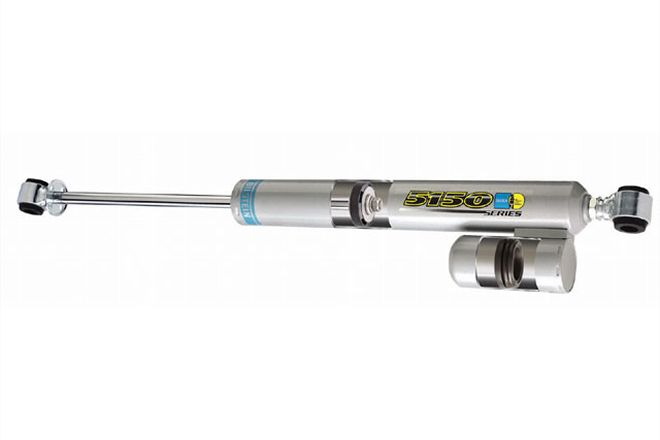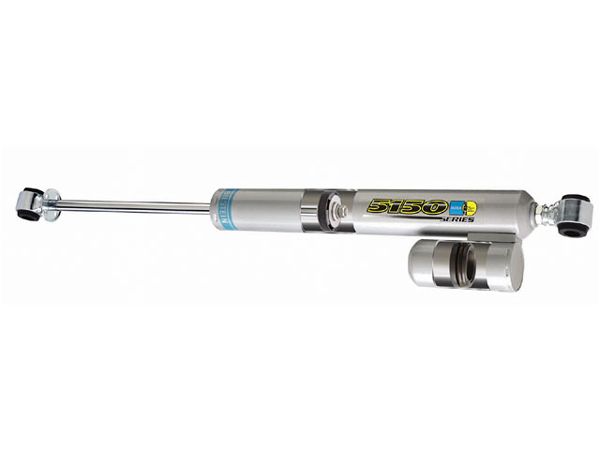
 Ken Brubaker
Senior Editor, Four Wheeler
Photographers:
The Manufacturers
Ken Brubaker
Senior Editor, Four Wheeler
Photographers:
The Manufacturers
 Here you can see a cutaway of a Bilstein 5150 Series remote-reservoir shock. This particular unit has a fixed-reservoir (or piggyback) design and was the first production monotube high gas pressure, fixed CrossFlow reservoir shock designed specifically for lifted and custom applications. The CrossFlow fixed-reservoir design expands oil capacity for enhanced cooling and it also allows for increased rod travel. This high-pressure (360 psi) nitrogen shock's reservoir features a "floating" dividing piston that eliminates the possibility of oil foaming and performance loss from shock fade. The monotube design provides superior tube strength while maximizing heat dissipation and shock life. It has a 46mm working piston and self-adjusting deflective disc valving (visible in the monotube), which allows for maximum vehicle body control and superior performance. The 5150 can be valved for single- or multiple-shock applications; it is available in 6.5 to 14 inches of travel and has a platinum powdercoat finish.
Here you can see a cutaway of a Bilstein 5150 Series remote-reservoir shock. This particular unit has a fixed-reservoir (or piggyback) design and was the first production monotube high gas pressure, fixed CrossFlow reservoir shock designed specifically for lifted and custom applications. The CrossFlow fixed-reservoir design expands oil capacity for enhanced cooling and it also allows for increased rod travel. This high-pressure (360 psi) nitrogen shock's reservoir features a "floating" dividing piston that eliminates the possibility of oil foaming and performance loss from shock fade. The monotube design provides superior tube strength while maximizing heat dissipation and shock life. It has a 46mm working piston and self-adjusting deflective disc valving (visible in the monotube), which allows for maximum vehicle body control and superior performance. The 5150 can be valved for single- or multiple-shock applications; it is available in 6.5 to 14 inches of travel and has a platinum powdercoat finish.
Shock absorbers control unwanted motion through a process commonly called dampening (hence, their alias "dampeners"). They turn the kinetic energy of suspension movement into heat energy, which is then dissipated through the shock body. Without shocks, your rig's springs would bounce up and down after hitting a bump (taking your rig with them) until all of the energy put into the springs by the bump was used up. So a shock's job sounds simple, right?
Well, here's the thing. While fine for street use, a standard monotube or twin-tube shock has drawbacks. The biggest disadvantage is that when asked to endure sustained rough terrain, they can overheat. This is called aeration, and it's what takes place when the oil in the shock foams due to the heat generated by the shock, turning the previously mentioned kinetic energy of suspension movement into heat energy. The result is that the shock loses its ability to dampen. This allows that crazy spring motion to run unabated. This not only creates a bouncy ride but also scary handling.
Remote-reservoir shocks can help solve this problem. They're designed with an external reservoir that increases fluid capacity. This increase in capacity helps lower fluid temperature, thus offering the ability to blast over rough terrain without experiencing shock fade due to overheating.
There are two kinds of remote-reservoir shocks. One type has the reservoir permanently mounted to the shock body. These are often called "fixed reservoir" or "piggyback" shocks. The other type leaves the reservoir loose so you can mount it wherever you like, limited only by the length of the connecting hose.
But that's not all. There are many other benefits to remote-reservoir shocks besides cool operation. For instance, many are valved for specific vehicle applications, unlike most regular shocks that use generic valving. Many are easily rebuildable, so if a part fails, you can fix it yourself. Many are custom-valvable so you can fine-tune the compression and rebound to suit your rig and driving style. Further, many offer longer travel than their non-remote-reservoir counterparts. For those of you with custom suspensions, there are numerous manufacturers that offer a slew of universal remote-reservoir shocks in a variety of sizes and travel lengths with a number of mounting options.
So now you know how remote-reservoir shocks work and why you need 'em. Now you can read on to learn about some of the fascinating remote-reservoir offerings available from the shock aftermarket.





